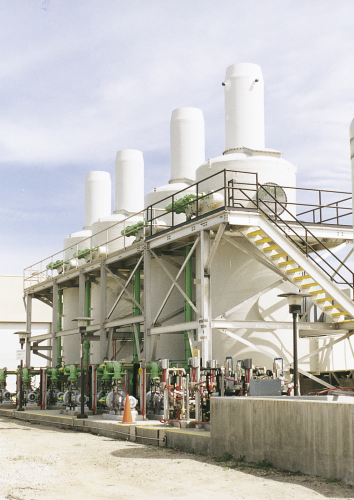
Metal prices often signal the recovery for FRP in corrosion service. In the last year, we have seen metal prices plummet to near historic lows. When metal prices are down, stainless steel becomes very competitive with fibreglass composites. More importantly, metal prices are typically down because demand has decreased in the infrastructure markets – a sure sign that industrial activity is low. The International Stainless Steel Forum (ISSF) reports that stainless steel production dropped by almost 7% last year and is expected to contract another 17% in 2009. ISSF expects a modest rebound for stainless steel in 2010.
However, some geographies are moving forward. In China, government stimulus packages are increasing infrastructure build. And Chinese steelmakers are taking advantage of favorable prices to acquire stakes in major Australian iron ore mining projects. Once stainless steel demand returns to China and India, we should see global resurgence in the FRP market for corrosion. The JEC reports that economic growth rates for emerging countries should return to 6% a year by 2010 or 2011. Developed countries are projected to grow at 1-2% in the same time period.
With the vacatur of the Clean Air Mercury Rule (CAMR) last year and the uncertainties around the current Clean Air Interstate Rule (CAIR), the US air pollution control market is currently in a state of disarray. Utility owners are also haunted by the likelihood that the Environmental Protection Agency (EPA) may also pass restrictive guidelines on greenhouse gas emissions for coal-fired power plants.
Under CAMR, many US coal-fired power plants would be mandated to cut mercury emissions below current levels by 2010, with additional reductions scheduled by 2018. With the vacatur of CAMR, these same utilities are now regulated under a maximum achievable control technology (MACT) standard, which is much stricter than the 70% reduction required under CAMR. The ruling has serious implications for coal-fired power plants that are seeking permits or have already received permits because they now have to achieve at least a 90% mercury removal rate.
Two days before Christmas last year, the D.C. Court of Appeals reinstated CAIR while instructing the EPA to make significant changes to it. The EPA informed the Court that development and finalisation of a replacement rule could take as long as two years. However, it is certain that further emission reductions of sulphur dioxide (SO2) and nitrogen oxide (NOx), as well as reductions in mercury and possibly carbon dioxide (CO2), must occur in the power sector to address health and environmental impacts of air pollution as required by the Clean Air Act. In 2007, according to US EPA statistics, power generation was responsible for 71% of all SO2 emissions, 22% of NOx emissions and 44% of mercury emissions. The power sector also generates 39% of all CO2 emissions.
When it comes to controlling SO2, NOx and mercury, the EPA has repeatedly stated that coal-fired generation can achieve significant reductions and still compete effectively given its relatively low operating costs compared to other fossil fuels, nuclear and renewables. This conclusion is far less certain when CO2 reduction is thrown into the mix. However, more recent analysis at EPA suggests that clean-coal technologies, including Integrated Gasification Combined Cycle (IGCC), carbon capture and sequestration, could allow coal-fired utilities to remain competitive even with CO2 regulation.
Corrosion resistant FRP is used extensively in air pollution control systems for NOx and SO2 reduction. The environment in these processes is highly corrosive to stainless steels and even high nickel alloys. As a direct result, FRP composites made from Ashland's DERAKANE® and HETRON® epoxy vinyl ester resins have become the preferred material of construction in many facets of air pollution control equipment. With a 30 year reputation for low maintenance and relatively stable cost, FRP provides process engineers with a reliable, cost-effective construction material.
Over the next decade, owners of coal-fired power plants around the globe are expected to spend over $200 billion to add flue gas desulphurisation (FGD) systems to existing and new combustion units. Most of this investment is expected to be in the US and China. Nonetheless, many emerging industrial nations, such as India and South Africa, are also investing heavily in air pollution control technologies. There will be a significant need for corrosion resistant FRP in these new facilities. Stack liners, limestone slurry piping, process water recycle lines, scrubber systems and wastewater treatment tanks are some of the many applications for FRP in these air pollution control systems.
Unfortunately, no one really knows when the FRP corrosion market will return to the levels of growth and profitability experienced during the last five years. In a recent survey from the National Association for Business Economics more than 90% of US economists predicted that the recession will end this year although the recovery is expected to be rather bumpy. Fabricators of corrosion resistant fibreglass can only be hopeful that this time next year they will be very busy once again.
This article is reprinted from the Summer 2009 edition of The Corrosion Chronicle newsletter published by Ashland Inc.


